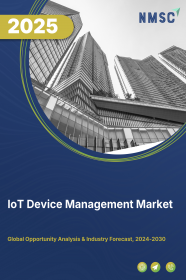
IoT Device Management Market by Component (Software and Services), by Deployment Model (Public Cloud, Private Cloud, and Hybrid Cloud), by Organization Size (Large Enterprises and Small and Medium-Sized Enterprises (SMEs)), by Application (Real-Time Streaming Analytics, Security Solution, Data Management, Remote Monitoring, Network Bandwidth Management, and Others), and by End User - Global Opportunity Analysis and Industry Forecast 2024-2030
Market Definition:
The global IoT Device Management Market size was valued at USD 5.39 billion in 2023 and is predicted to reach USD 26.79 billion by 2030 with a CAGR of 28.20% from 2024-2030.
Internet of Things (IoT) device management is the process that involves provisioning, authenticating, configuring, maintaining, monitoring, and diagnosing connected devices operating as a component of an IoT environment. These components enable and support the full range of functional capabilities of connected devices such as smartphones, smart vehicles, and smart refrigerators.
Therefore, having a dependable and efficient device management system is essential for keeping smart devices connected, safe, and up-to-date. IoT device management enables the product owner to track, manage, monitor, track, maintain, and protect connected devices. It is used in logistics, agriculture, and smart homes.
Market Dynamics and Trends:
The increasing adoption of network and communication technologies as well as the global demand for digitization is driving the use of IoT and cloud-based technologies which in turn has been driving the IoT device management market growth. Also, rising requirement for a single device to manage connected devices with full capabilities while ensuring best performance is expected to fuel market growth.
For instance, Amazon Echo Plus Voice connects to Alexa Voice service that can control and manage activities such as play music, ask questions, make calls, and news instantly. Moreover, the growing adoption of industry 4.0, is transforming industries from having legacy systems to having smart components & smart machines. The IoT device management enables to support digital factories and the growth of an ecosystem of interconnected businesses & plants across business operations further boosts the market.
However, data privacy concerns, lack of management of IoT mechanism and interoperability among devices across networks are the factors that are expected to restrain the growth of market during the forecast period. On the contrary, growing advancement in technology coupled with rising number of automated devices in the IoT ecosystem such as google home voice controller, amazon echo plus voice controller and amazon dush button are expected to create ample growth opportunities for the market in the coming years.
Market Segmentations and Scope of the Study:
The IoT device management market report is segmented on the basis of component, deployment model, organization size, application, end user, and geography. On the basis of component, the market is divided into software and services. On the basis of deployment model, the market is classified into public cloud, private cloud, and hybrid. On the basis of organization size, the market is categorized into large enterprises and small and medium-sized enterprises (SMEs). On the basis of application, the market is bifurcated into real-time streaming analytics, security solution, data management, remote monitoring, network bandwidth management, and others. On the basis of end user, the market is segmented into BFSI, IT & telecom, manufacturing, healthcare, and others. Geographic breakdown and analysis of each of the aforesaid segments includes regions comprising of North America, Europe, Asia-Pacific, and RoW.
Geographical Analysis:
North America holds the lion share of IoT device management market at present and is expected to continue dominating the market during the forecast period. This is attributed to development of advanced technologies such as cloud computing, IoT platforms and IoT-based Streaming Analytics in this region. Also, rising number of connected devices and increasing IoT deployment in US is driving the growth of the market in this region.
For instance, in 2019, according to Consumer Technology Association, around 30.6 million smart home devices were shipped in the US. In addition, rising number of internet users in North America is expected to drive the growth of the IoT device management market in this region.
However, Asia-Pacific is expected to show a steady rise in the IoT device management market due to high population leading to rising uses of smartphones, advanced technologies such as artificial intelligence (AI), IoT analytics & machine learning along with growing number of smart cities in developing countries such as Papua New Guinea, Philippines, and India in this region. Moreover, increasing adoption of IoT to improve productivity and optimize operations among various industries in countries such as China and Japan are expected to drive the market growth in this region.
Competitive Landscape:
The IoT device management industry comprises of various market players such as Intel Corporation, Qualcomm Technologies, Texas Instruments Incorporated, STMicroelectronics, IBM Corporation, Amazon Web Services Inc., Oracle Corporation, Microsoft Corporation, PTC Incorporation and Telit Communications PLC. These market players are adopting various joint venture strategies, partnership and planning expansion of business across various regions to maintain their dominance in the global market.
For instance, in June 2022, Qualcomm announced partnership with Oppo and Ericsson to accelerate the deployment of 5G enterprise network slicing. In collaboration with the partners, the companies achieved connection between the core network, wireless network and chip module. These companies worked hard to complete IoT ecosystem, device, and network specifications in preparation for commercial deployment. Also, in April 2022, Amazon Web Services (AWS) launched AWS IoT Twin Maker, a new AWS IoT service. This new service created digital twins of real-world systems more quickly and easily that was used to track and improve industrial processes.
Key Benefits:
-
The IoT device management market report provides a quantitative analysis of the current market and estimations through 2022-2030 that assists in identifying the prevailing market opportunities to capitalize on.
-
The study comprises a deep dive analysis of the IoT device management market including the current and future trends for depicting the prevalent investment pockets in the market.
-
The information related to key drivers, restraints and opportunities and their impact on the market is provided in the report.
-
The competitive analysis of the market players along with their market share in the global market.
-
The SWOT analysis and Porters Five Forces model is elaborated in the study.
-
Value chain analysis in the market study provides a clear picture of the stakeholders’ roles.
IoT Device Management Market Key Segments:
By Component
-
Software
-
Services
By Deployment Model
-
Public Cloud
-
Private Cloud
-
Hybrid Cloud
By Organization Size
-
Large Enterprises
-
Small and Medium-Sized Enterprises (SMEs)
By Application
-
Real -Time Streaming Analytics
-
Security Solution
-
Data Management
-
Remote Monitoring
-
Network Bandwidth Management
-
Others
By End User
-
BFSI
-
IT
-
Manufacturing
-
Healthcare
-
Others
By Geography
-
North America
-
U.S
-
Canada
-
Mexico
-
-
Europe
-
UK
-
Germany
-
France
-
Italy
-
Spain
-
Rest of Europe
-
-
Asia-Pacific
-
China
-
India
-
Japan
-
South Korea
-
Australia
-
Rest of Asia-Pacific
-
-
RoW
-
UAE
-
Saudi Arabia
-
South Africa
-
Brazil
-
Remaining countries
-
Key Players
-
Intel Corporation
-
Qualcomm Technologies
-
Texas Instruments Incorporated
-
STMicroelectronics
-
IBM Corporation
-
Amazon Web Services Inc.
-
Oracle Corporation
-
Microsoft Corporation
-
PTC Incorporation
-
Telit Communications PLC.




















 Speak to Our Analyst
Speak to Our Analyst
























